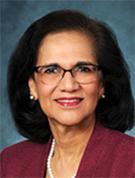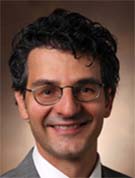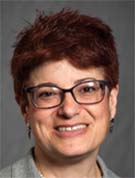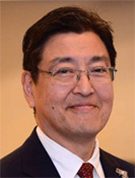Mentors Play Critical Role for Female, Minority Radiologists
Mentoring can help female and minority radiologists prepare for radiologic leadership



Finding a role model who can point you in the right direction is important to anyone in the burgeoning stages of a radiology career. But for female and minority radiology residents and early-career professionals who may face obstacles on a number of fronts, finding the right mentor is an essential step to ensuring fulfillment and longevity in the field.
However, a lack of diversity in radiology leadership positions is creating a void for young female and minority radiologists looking for a path forward or some daily perspective.
For those fortunate enough to find them, mentorship has become an impactful way to increase diversity throughout radiology, according to Vijay M. Rao, MD, the David C. Levin Professor and Chair of Radiology at Sidney Kimmel Medical College of Thomas Jefferson University and senior vice president and chair of Enterprise Radiology and Imaging at Jefferson Health, both in Philadelphia.
“Mentees like to find mentors who, in addition to sharing gender or race, might also be of the same educational background or who are of the same generation or only one generation removed,” Dr. Rao said. “This can be difficult to find and mentees may lose out on tremendous expertise and guidance by limiting themselves in this way.”
Multigenerational collaboration in clinical, academic and professional radiology settings can be beneficial, no matter what your career stage, Dr. Rao noted. Dr. Rao, RSNA president, cites her own experiences with RSNA, where a diverse variety of volunteers are working at various leadership levels.
Over the last 10 years, roughly 30 percent of RSNA’s major committees have been led by women and 33 percent of the Society’s board members have been women. Dr. Rao is the third female president of RSNA in the past decade.
“Mentorship and leadership go hand in hand,” Dr. Rao said. “True mentoring is more than just answering occasional questions or providing ad hoc help. It’s an ongoing relationship of learning, dialogue and challenge that can direct female and minority radiologists to experiences and advantages that will benefit them when they move into radiologic leadership.”
A Leadership Pipeline for Female and Minority Radiologists
Creating those leadership opportunities for female and minority radiologists is important personally and to the healthof the specialty, according to Reed Omary, MD, the Carol D. & Henry P. Pendergrass Professor and Chairman, Department of Radiology and Radiological Sciences at Vanderbilt University Medical Center in Nashville.
“Why wouldn’t radiology — or any profession for that matter — want to include diverse voices?” Dr. Omary said. “There is value and insight to gain from women and minorities entering our specialty. Radiology will be more successful in the future if we empower women and minorities to be part of, and leaders in, that success.”
Dr. Omary describes mentorship as serving like an “academic care provider” that fosters the health of the mentee, their career and their department.
“Regularly meeting with junior female and minority radiologists, as well as those in my peer group, has made me more aware of their needs and how our departments, medical centers and radiology as a whole can change to address their concerns,” Dr. Omary said. “The future of radiology can be enhanced by developing leadership incubators for women and minority radiologists to prepare them for leadership positions.”
Creating awareness about leadership opportunities in radiology has been the mission of Emory University’s Radiology Leadership Academy for nearly a decade. Over nine months, early- to mid-career faculty and staff can participate in teamwork and leadership programming designed to add diverse strength to the radiology department, the university as a whole, and the field.
“Mentoring plays a critical role in the advancement of women in medicine,” said Carolyn C. Meltzer, MD, William P. Timmie Professor and Chair, Department of Radiology and Imaging Sciences, Emory University School of Medicine, Atlanta. “Both senior female and male mentors can help to provide local and national opportunities for young female radiologists to grow professionally and build confidence. Having someone to identify key leadership opportunities and give young radiologists self-assurance to seek those opportunities, can make a huge difference in how diverse radiology leadership becomes.”
Mentoring Enhances Professional and Personal Success
Gelareh Sadigh, MD, a neuroradiology fellow at Emory, who has Dr. Meltzer as a department chair and mentor, points out that mentors also make excellent role models.
“In a strong mentoring relationship, the mentee should look up to the mentor and consciously or unconsciously become more interested and have more respect for the type of work the mentor does,” Dr. Sadigh said. “This is critically important when mentorships are initiated in medical school before a specialty is selected, because radiology is only an elective for many medical students. Having a radiologist as a mentor can increase awareness and interest in the field.”
Having more than one mentor is also a good option said Katarzyna J. Macura, MD, PhD, professor of radiology, urology and oncology, The Johns Hopkins University, Baltimore.
“For female and minority radiologists, having more than one mentor can be beneficial as each can provide a unique purpose and demonstrate a different skill set or scenario for career advancement,” Dr. Macura said. “Young women should be proactive in seeking mentors who can help them build their networks at a local, national and international level.”
One of Dr. Macura’s mentees is Kristin Porter, MD, PhD, assistant professor, abdominal imaging at University of Alabama at Birmingham. Dr. Macura is not Dr. Porter’s only mentor.
“I have several mentors, including the chair of my department and my section chief,” Dr. Porter said. “Since I have switched institutions, Dr. Macura and I typically only meet in person at annual society meetings, such as RSNA. However, I meet or speak with my mentors at my home institution regularly to make sure that I have identified achievable goals and have a path to complete them.”
With a dearth of female and minority radiologists in leadership positions, finding a local mentor can be challenging, but technology can help maintain mentoring relationships regardless of location.
Nolan Kagetsu, MD, associate professor of clinical radiology, Icahn School of Medicine at Mt. Sinai, New York, met Dr. Omary online and now they keep in touch by direct Twitter messaging, whether to discuss a pressing daily challenge or to gain perspective on potential research.
“Mentoring can be accomplished in many forums and social media, particularly Twitter, can help connect junior and senior radiologists,” said Dr. Kagetsu, who later met Dr. Omary during a conference. “If you have established a relationship online, when you do meet in person, you have a foundation for forming a mentoring relationship.”





Mentoring Students Early
Mentoring can be successful in creating interest in radiology even before a student is considering a medical career. STEM (science, technology, engineering and math) and STEAM (science, technology, engineering, arts and math) programs in middle and high schools are becoming prominent opportunities where radiologists can envision introducing the specialty to potential students.
“Many radiologists volunteer and engage with pre-college students,” Dr. Macura said. “Early exposure to medical specialties, especially for women, can inspire an interest to pursue that field through further education. And if you have made a connection with that student, that can result in a positive mentoring relationship.”
Dr. Meltzer says nearly all STEM fields suffer from lack of women seeking training.
“There is extensive evidence that early socialization, societal constructs and implicit bias contribute to deterring young women from being exposed to design and mechanical learning,” Dr. Meltzer said. “If we can engage girls and young women in early pre-medical education, we could empower them to consider STEM fields, such as radiology.”
Anne Gill, MD, assistant professor of radiology, Emory University School of Medicine, would have appreciated more female role models or even mentors in the medical field while she was a high school student or an undergraduate.
As a nursing technician before starting medical school she developed a mentoring relationship with a nursing manager in the emergency department and they still stay in touch.
“Even though I was early in my medical education and I knew that I was not going to pursue a nursing career, I keep in touch with her because she provides me with a unique perspective from within medicine, but not from my particular specialty,” Dr. Gill said.
Mentorship Encourages and Emboldens
Most radiologists would agree that mentoring enhances the course to success and improves personal and professional advancement for women and minorities in radiology.
“Mentoring is important to many aspects of career success, including job satisfaction, career commitment, promotions, and ultimately, compensation,” Dr. Macura said. “Studies have shown that connecting with a mentor can allow someone to become more focused on strategies for success and enhance opportunities to advance in their specialty area.”
Dr. Rao would agree that mentoring is a terrific return on investment for both the mentor and mentee.
“Mentoring in radiology creates a culture where everyone is seeking to be a bit better tomorrow than they are today,” Dr. Rao said. “That sense of continued progress can extend from the mentor and mentee to others in their professional circle and department and, hopefully, to the specialty itself.”
